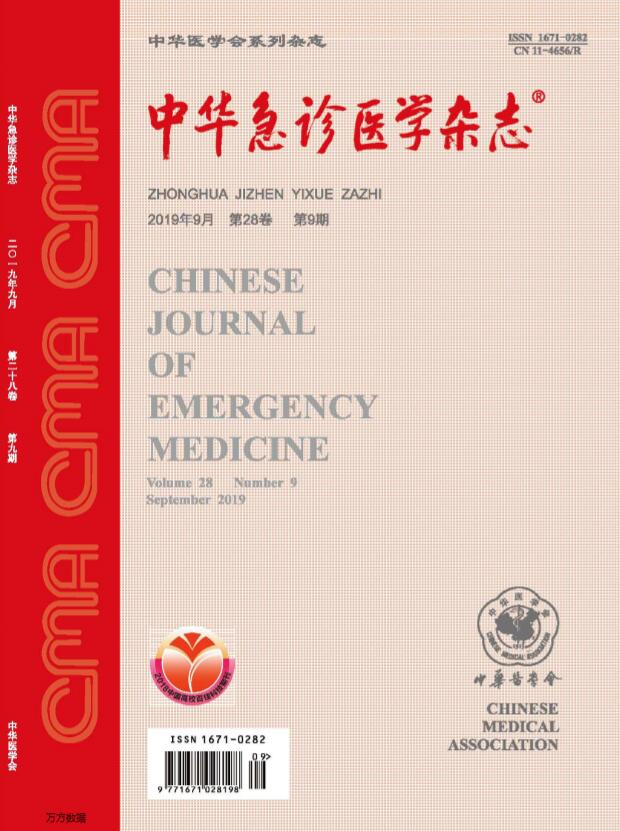Analysis of clinical features of 58 patients with severe or critical 2019 novel coronavirus pneumonia
Q4 Nursing
引用次数: 6
Abstract
Objective To analyzethe clinical features of severe or critical 2019 novel coronavirus pneumonia (COVID-19) patients. Methods Clinical data of 58 patients with severe or critical COVID-19 in Wuhan Union Hospital, Tongji medical college of Huazhong University of Science and Technology from January 29 to February 26 in 2020 were collected. The general information, clinical symptoms, resultsofblood testand chest computed tomography (CT) imaging, treatments and outcomes of patients were analyzed retrospectively. Results 36 severe cases (62.1%) and 22 critical cases (37.9%) , 28 males (48.3%) and 30 females (51.7%) , with average age of (62.12±12.95) years were enrolled. 48.2% of the patients had underlying disease including Hypertension (21 cases, 36.2%), Diabetes mellitus (11 cases, 19.0%), Coronary heart disease (6 cases,10.3%), Chronic renal failure (2 cases, 3.4%) and Malignant tumor (1 case, 1.7%). The symptoms included fever (54 cases, 93.1%), dyspnea (48 cases, 82.8%),cough (46 cases, 79.3%), muscle soreness (32 cases, 55.2%), sore throat (15 cases, 25.9%) and diarrhea (6 cases, 10.3%). Decreased or increased white blood cell count was found in 12.1% and 10.3% of the patients.Decreased percent of lymphocyte, increased percent of neutrophil, and decreased hemoglobin level were found in 60.3%, 46.6%, and 41.4% of the patientsrespectively. Elevated CRP, PCT and D-dimmer level were demonstrated in 65.5%, 62.1%, and 77.5% of the cases. Increased level of ALT, AST, LDH and decreased serum albumin were found in 55.2%, 43.1%, 67.2% and 74.1% of all the patients respectively.The main features of CT were patchy shadows and ground glass shadows, bilateral and peripheral distribution, consolidation and interlobular septal thickening were found in most of the patient’s lungs. 29 cases (50.0%) were treated with antibiotics, and 14 cases (24.1%) with systemic glucocorticoid. In addition to supportive and antivirustreatment,oxygen therapy methods including nasal catheter (9 cases, 15.5%), oxygen mask (33 cases, 56.9%), high-flow nasal catheter (8 cases, 13.3%) and invasive mechanical ventilation were adopted in 15.5%, 56.9%, 13.3% and 13.3% of the patients. 21 patients (36.2%) had been discharged from the hospital, 27 patients (46.6%) in remission were still in the isolation wards, 3 patients (5.2%) had been to the ICU as the disease got worse, and 7 patients were dead. Conclusions Abouthalfofthe patients with severe/critical COVID-19 had underlying disease. severe/criticalCOVID-19 patients often showed extrapulmonary abnormity as well as lung dysfunction. Comprehensive treatment as early as possibly may be important for prognosis improvement of these patients. Key words: 2019 novel coronavirus pneumonia; Clinical features; Disease severity58例重症或危重2019新型冠状病毒肺炎患者临床特征分析
目的分析2019年新型冠状病毒肺炎(新冠肺炎)重症或危重症患者的临床特点。方法收集华中科技大学同济医学院武汉协和医院2020年1月29日至2月26日收治的58例重症或危重症新冠肺炎患者的临床资料。回顾性分析患者的一般情况、临床症状、验血和胸部计算机断层扫描(CT)结果、治疗和结果。结果36例重症病例(62.1%)和22例危重病例(37.9%),28例男性病例(48.3%)和30例女性病例(51.7%),平均年龄(62.12±12.95)岁。48.2%的患者有潜在疾病,包括高血压(21例,36.2%)、糖尿病(11例,19.0%)、冠心病(6例,10.3%)、慢性肾功能衰竭(2例,3.4%)和恶性肿瘤(1例,1.7%)。症状包括发烧(54例,93.1%)、呼吸困难(48例,82.8%)、咳嗽(46例,79.3%)、肌肉酸痛(32例,55.2%),咽痛15例,占25.9%;腹泻6例,占10.3%。淋巴细胞百分比下降,中性粒细胞百分比上升,血红蛋白水平下降的患者分别为60.3%、46.6%和41.4%。65.5%、62.1%和77.5%的病例显示CRP、PCT和D-二聚体水平升高。ALT、AST、LDH升高,血清白蛋白下降的比例分别为55.2%、43.1%、67.2%和74.1%。CT主要表现为斑片状影和磨玻璃影,患者肺部多见双侧及外周分布、实变和小叶间隔增厚。抗生素治疗29例(50.0%),全身糖皮质激素治疗14例(24.1%)。除支持性和抗病毒外,15.5%、56.9%、13.3%和13.3%的患者采用了导鼻管(9例,15.5%)、氧气面罩(33例,56.9%)、高流量导鼻导管(8例,13.3%)和有创机械通气等氧疗方法。21名患者(36.2%)已出院,27名病情缓解的患者(46.6%)仍在隔离病房,3名患者(5.2%)随着病情恶化进入重症监护室,7名患者死亡。结论重症/危重型新冠肺炎患者有潜在疾病。严重/危重的COVID-19患者通常表现出肺外异常和肺功能障碍。尽早进行综合治疗对改善这些患者的预后可能很重要。关键词:2019新型冠状病毒肺炎;临床特征;疾病严重程度
本文章由计算机程序翻译,如有差异,请以英文原文为准。
求助全文
约1分钟内获得全文
求助全文
来源期刊

中华急诊医学杂志
Nursing-Emergency Nursing
CiteScore
0.10
自引率
0.00%
发文量
8629
期刊介绍:
Chinese Journal of Emergency Medicine is the only national journal which represents the development of emergency medicine in China. The journal is supervised by China Association of Science and Technology, sponsored by Chinese Medical Association, and co-sponsored by Zhejiang University. The journal publishes original research articles dealing with all aspects of clinical practice and research in emergency medicine. The columns include Pre-Hospital Rescue, Emergency Care, Trauma, Resuscitation, Poisoning, Disaster Medicine, Continuing Education, etc. It has a wide coverage in China, and builds up communication with Hong Kong, Macao, Taiwan and international emergency medicine circles.
 求助内容:
求助内容: 应助结果提醒方式:
应助结果提醒方式:


